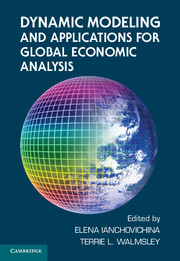Book contents
- Frontmatter
- Contents
- Contributors
- Acknowledgments
- PART I INTRODUCTION AND OVERVIEW
- PART II STRUCTURE OF THE DYNAMIC GTAP FRAMEWORK
- PART III APPLICATIONS OF DYNAMIC GTAP
- 8 Assessing the Impact of China's WTO Accession on Investment
- 9 Dynamic Effects of the “New-Age” Free Trade Agreement between Japan and Singapore
- 10 Resource Use and Technological Progress in Agriculture
- 11 Global Economic Integration and Land-Use Change
- 12 The Contribution of Productivity Linkages to the General Equilibrium Analysis of Free Trade Agreements
- 13 Global Demographic Change, Labor Force Growth, and Economic Performance
- PART IV EVALUATION OF THE DYNAMIC GTAP FRAMEWORK
- Appendix: Negative Investment: Incorporating a Complementarity into the Dynamic GTAP Model
- Glossary of GDyn Notation
- Index
- References
12 - The Contribution of Productivity Linkages to the General Equilibrium Analysis of Free Trade Agreements
Published online by Cambridge University Press: 05 June 2012
- Frontmatter
- Contents
- Contributors
- Acknowledgments
- PART I INTRODUCTION AND OVERVIEW
- PART II STRUCTURE OF THE DYNAMIC GTAP FRAMEWORK
- PART III APPLICATIONS OF DYNAMIC GTAP
- 8 Assessing the Impact of China's WTO Accession on Investment
- 9 Dynamic Effects of the “New-Age” Free Trade Agreement between Japan and Singapore
- 10 Resource Use and Technological Progress in Agriculture
- 11 Global Economic Integration and Land-Use Change
- 12 The Contribution of Productivity Linkages to the General Equilibrium Analysis of Free Trade Agreements
- 13 Global Demographic Change, Labor Force Growth, and Economic Performance
- PART IV EVALUATION OF THE DYNAMIC GTAP FRAMEWORK
- Appendix: Negative Investment: Incorporating a Complementarity into the Dynamic GTAP Model
- Glossary of GDyn Notation
- Index
- References
Summary
Introduction
Despite the economic arguments in favor of conducting trade negotiations multilaterally under the auspices of the WTO, there have been more than 100 regional trade agreements signed since the WTO was created in 1995 (WTO 2002). The European Union, for example, signed regional trade agreements with 20 nations between 1991 and 2001 –most of them developing countries (WTO 2002). Not to be left out, the United States continues to explore the possibility of extending NAFTA further to the south, with a free trade agreement (FTA) of the Americas as the ultimate goal. A free trade agreement between the United States and Chile was concluded in 2003, and discussions are under way with other nations. The boom in regional agreements has also spread to East Asia. For example, officials from ASEAN and China have endorsed the concept of a free trade agreement between those two regions. Japan, long a staunch advocate of multilateralism, concluded an FTA with Singapore in 2001 (see Chapter 9) and has also been involved in active negotiations with other countries, including Mexico (signed in 2004), ASEAN (signed in 2008), Korea, and China.
Alongside this surge in interest in FTAs has been a corresponding increase in the number of quantitative analyses of such agreements, most of which employ AGE models.
- Type
- Chapter
- Information
- Dynamic Modeling and Applications for Global Economic Analysis , pp. 312 - 341Publisher: Cambridge University PressPrint publication year: 2012



